Tensor fascia lata muscle Anatomy
Table of Contents
Introduction
- The tensor fasciae latae (TFL) is a muscle of the proximal anterolateral thigh that is located between the superficial & deep fibers of the iliotibial (IT) band. There is high variability in muscle belly length, although, in most patients, the tensor fasciae latae muscle belly ends before the greater trochanter of the femur. This muscle is about 15cm in length.
- The tensor fasciae latae works in conjunction with the gluteus maximus, gluteus medius, & gluteus minimus in a wide variety of hip movements, including flexion, abduction,& internal rotation.
- It acts, via the iliotibial (IT) band’s attachment to the tibia, to assist with knee flexion & lateral rotation.
- The tensor fasciae latae is most important clinically for assisting in pelvis stability while standing & walking.
Origin, and Insertion of Tensor fascia lata muscle
- The tensor fasciae latae arises from the anterior superior iliac spine (ASIS) & anterior aspect of the iliac crest. It descends
- between & is attached to the deep fascia & the superficial fascia of the IT band (5 cm width). The tensor fasciae latae descends on the anterolateral aspect over the thigh, running superficially to the greater trochanter of the femur.
- It inserts distally to the IT track/band, which is comprised of the fascial aponeurosis of the gluteus maximus & the tensor fascia latae. The iliotibial band then runs along the lateral aspect of the thigh, where it attaches to the lateral condyle of the tibia, specifically the Gerdy tubercle.
Structure of TFL
- It originates from the anterior part of the outer lip of the iliac crest; from the outer surface of the anterior superior iliac spine, & part of the outer border of the notch below it, between the gluteus medius & sartorius; & from the deep surface of the fascia lata.
- It is inserted between the 2 layers of the iliotibial tract of the fascia lata about the junction of the middle & upper thirds of the thigh. The tensor fasciae latae tautens the iliotibial tract & braces the knee, especially when the opposite foot is lifted. The terminal insertion point is located on the lateral condyle of the tibia.
Function of Tensor fascia lata muscle
- The tensor fasciae latae is a tensor of the fascia lata; it resumes its action, and the oblique direction of its fibers enables it to stabilize the hip in extension (assists gluteus maximus during hip extension). The tensor fascia lata muscle is a fibrous sheath that encircles the thigh like a subcutaneous stocking & tightly binds its muscles. On the lateral part, it combines with the tendons of the gluteus Maximus muscle & tensor fasciae latae to form the iliotibial tract, which extends from the iliac crest to the lateral condyle of the tibia.
- In the erect posture, acting from below, it will serve to steady the pelvis upon the head of the femur; & by means of the iliotibial tract, it steadies the condyles of the femur on the articular surfaces of the tibia, & assists the gluteus maximus muscle in supporting the knee in a position of extension.
- The basic functional motion of tensor fasciae latae is walking. The tensor fasciae latae muscle is heavily used in horse riding, hurdling & water skiing. Some problems that arise when this muscle is tight/shortened are pelvic imbalances that lead to pain in the hips, as well as pain in the lower back & lateral part of the knees.
- Because of its attache’s point on the lateral condyle of the tibia, it also aids in the lateral rotation of the tibia. This lateral rotation may be initiated in conjunction with hip abduction & medial rotation of the femur while kicking a soccer ball. The tensor fasciae latae works in synergy with the gluteus medius muscle & gluteus minimus muscles to abduct & medially rotate the femur.
- The TFL is a hip abductor muscle. To stretch the tensor fasciae latae muscle, the knee may be brought medially across the body (adducted). If one leans against a wall with crossed legs (externally/laterally rotated hips) & pushes the pelvis away from the wall (leaning the upper body towards it) side bending the lumbar spine (i.e.: curving the spine to the side) might be avoided as it stretches the lumbar region rather than the tensor fasciae latae & other muscles which cross the hip rather than the spine.
Relations
- The tensor fasciae latae muscle is the superficial muscle of the anterolateral portion of the thigh. It originated lateral to the hip joint, instantly beneath the skin. In its superior part, tensor fasciae latae is found between the sartorius & gluteus medius muscle, where it overlays the gluteus minimus muscle. While descending down the thigh, the muscle is found between the 2 layers of fascia lata.
- Due to its superficial aspect, this muscle is easily palpated. This is usually done at the area situated halfway between the anterior superior iliac spine & the greater trochanter of the femur.
Assessment
Power
- The power test for the tensor fascia latae is done in side-lying with the hip in 45° of flexion for grades 5, 4 & 3 while for grades 2, 1 & 0, it is done in a long sitting position.
- The therapist stands behind the patient with one hand placed at the lateral surface of the topmost thigh immediately above the knee, given downward pressure & the other hand at the iliac crest for stability. the patient is asked to abduct motion against resistance.
Grade 5 is given if the patient is able to abduct & maintain a position at the end range against maximal resistance.
Grade 4 is given if the patient is able to abduct & maintain a position at the end range against moderate resistance.
Grade 3 is given if the patient is able to abduct & maintain a position at the end range against no resistance except gravity.
The therapist stands at the side of the limb being assessed 1 hand is placed at the ankle serving to reduce friction between the limb & the plinth while the other hand is placed at the proximal anterolateral portion of the thigh. The patient is asked to move the limb towards the physical therapist.
Grade 3 is given if the patient is able to abduct to 30° & maintain a position at the end range.
For grades 1 & 0, the starting position is the same for the grade 3 assessment but the hand placement of the therapist changes; one hand is placed at the lateral side of the thigh instantly above the knee while the other hand is placed at the proximal anterolateral thigh for ease of TFL palpation. The patient is asked to move the limb toward the physical therapist. Grade 1 is given if the therapist is able to feel the contraction of the muscle & grade 0 is given if no contraction is palpable.
Palpation
- Palpation of Tensor Fasciae Latae can be done in any of the aforementioned starting positions in muscle power testing. 1 hand is placed at the lateral part of the thigh instantly above the knee while the other hand is placed at the proximal anterolateral thigh & the patient is instructed to abduct the limb being assessed. Tensor Fasciae Latae can then be easily palpable at the end range of the movement
- The Ober’s test evaluates a tight, contracted, or inflamed Tensor Fasciae Latae (TFL) & Iliotibial band (ITB). Noble’s test & the Renne test are 2 other tests that are commonly used to detect iliotibial band syndrome.
Ober Test :
Frank Ober described the test for tightness of TFL & ITB in an article entitled “Back Strain & Sciatica”, wherein he discussed the relationship of a contracted TFL & ITB to low backache.
Test position :
The patient might be side-lying with the affected side up.
The bottom knee & hip should be flexed to flatten the lumbar curve.
Stand behind the patient & firmly stabilize the pelvis/greater trochanter to prevent movement in any direction.
Grasp the distal end of the patient’s affected leg with your other hand & flex the leg to a right angle at the knee
Test:
Extend & abduct the hip joint.
Gradually lower the leg toward the table -adduct hip- until motion is restricted.
Ensure that the hip does not internally rotate & flex during the test & the pelvis must be stabilized. As allowing the thigh to drop in flexion & internal rotation would ‘give in’ to the tight TFL and not accurately test the length.
Results:
If the ITB is normal, the leg will adduct with the thigh dropping down slightly below the horizontal & the patient won’t experience any pain; in this case, the test is known as negative.
If the ITB is tight, the leg would remain in the abducted position & the patient would experience lateral knee pain, in this case, the test is known as positive.
Modified Ober Test
A modification of the Ober test was 1st recommended by Kendalls in Posture & Pain. In this test, there is less strain on the medial part of the knee joint, less tension on the patella, and less interference by a tight Rectus Femoris muscle & it provides a complete stretch on TFL.
Test position:
The patient is in a side-lying position with the underneath leg flexed at the hip & knee to flatten the low back.
The examiner stabilizes the pelvis & keeps the lateral trunk in contact with the table.
Note: Downward lateral tilt is equivalent to the hip abduction & which would “give in to a tight TFL.
Test:
The examiner extends the leg and the leg is not internally rotated.
Results:
With the knee straight & the pelvis in a neutral position, the thigh drops about 10 degrees below the horizontal. It is suggestive of normal length.
Clinical importance
Tensor Fascia Latae muscle pain
- This Tensor Fascia Latae pain happens due to tightness & soreness in the muscle, which mostly occurs in runners.
- This Tensor Fascia Latae pain occurs due to many causes like Hip Osteoarthritis, Knock knee (valgus) posture.
- Tensor fasciae latae pain trigger points are in the hip joint part & an anterolateral part of the thigh that extends as far as the knee joint.
- This pain is felt such as deep hip pain which is further aggravated by walking and laying down on the affected side.
- The patient feels Pain which is refer to the outside of the thigh, and outer hip joint & when lying on the affected side hip joint.
- This pain is Increased when the patient is doing the weight-bearing on one side.
- Difficulty in walking fastly.
- The patient feels Trouble laying down on the affected side.
- The patient feels Difficulty sitting for long periods with the hip joint flexed up to 90 degrees or more.
- In the patient tender, the point is also present in the Tensor Fascia Latae muscle.
- The patient also presents muscle spasms due to overuse of the muscle.
- The patient feels weakness in the leg on the affected side
Hip Osteoarthritis :
- When the person is suffering from Tensor Fascia Latae which is sometimes developed in the hip osteoarthritis on the affected side.
- This happens due to the new biomechanics in the Tensor Fascia Latae muscle which places excess stress &strain on the structures of the hip joint.
- This muscle stress & strain ultimately leads to the early onset of degeneration & inflammation of the hip joint structures, which is give to result in osteoarthritis condition.
Tension & tightness:
- This Muscle pain is also associated with the tense & tight compensating muscles.
- These muscles’ Tension & tightness are due to the high alert which is issued by the brain.
- When the muscle is on high alert & ready to spring into action at all times it increased muscular tone & feels as when the muscle is unable to fully lengthen.
- When the muscle remains in this position for a long time it is unable to relax & recover from the tightness muscle & it will become chronically tight & shortened of muscle.
- If the patient’s posture is Poor, many positions & movements which contribute to TFL tightness.
Knock knee (valgus) posture:
- Due to the Tensor Fascia Latae muscle pain & tightness which is sometimes to the internal rotator of the hip joint, it is twisting the thigh inward from the hip joint, it can become shortened & tight resulting in a position known as the knock knees position where the one/ both of the knees are become to internally rotated.
Anterior pelvic tilt:
- Another posture created is the result of a Tensor Fascia Latae muscle tightness which is the source of muscle pain in an anterior pelvic tilt.
- This abnormal posture is possible by the Tensor Fascia Latae muscle pain because the TFL muscle is doing the movement of the hip flexion motion
- In the standing position, the legs are anchored due to the Tensor Fascia Latae muscle tightness pulling the front of the pelvis where the originates down & gives resulting in the anterior pelvic tilt.
Lateral pelvic tilt:
- On the other side, when the happen tightness of the Tensor Fascia Latae muscle unilateral means in one side, which is pull this side of the pelvis down, which is given to results in the pelvis dropping to one side.
Tensor fasciae latae tightness
- When the Tensor fasciae latae tightness is tight & locked up, it may cause pain in the hip joint, groin, buttock, lower back (over the sacroiliac joint) & even the lateral aspect of the thigh.
- The Tensor fascia latae Tightness is most generally seen in adults and stretching exercise is very important for keeping the posture correct & also helps in reducing pain in the Hip & Knee pain.
- Tensor fascia latae Tightness will add tension through the iliotibial band.
- This increased tension in the ITB can create pain & irritation in the outer region of the knee, called ITB syndrome.
- Tightness of TFL is also general mostly sportsmen involved in horse riding, running, and cycling.
- The Tensor fascia latae (TFL) is a fusiform muscle enclosed between 2 layers of fascia lata with a length of 15cm approximately & overlying the gluteus minimus & some part of the gluteus medius.
- Its myotomes are the fourth lumbar nerve root (L4)
Tensor fasciae latae tightness symptoms :
Tight tensor fasciae latae cause back pain: And when we stand up, if it’s really tight, the muscle will pull us into kind of what we call an anterior pelvic tilt, which can compress the low back. There are many things that can be caused by tight tensor fasciae latae
Cycle with tensor fasciae latae pain: You may find that you have recurring knee or hip pain each year or develop it after cross-training or running. Tight tensor fasciae latae alone may not be problematic but when mixed with bike fit problems it is a season-ending injury waiting to happen. Traditionally, the tensor fasciae latae is ignored when it comes to cycling, it is time that stops.
Tight tensor fasciae latae cause groin pain: IT can include hip, groin, & outer knee pain that feels sharp,
stabbing, and burning, as well as a click or pop. Usually, symptoms onset gradually and then worsen with continued running & other repetitive activities.
Tight tensor fasciae latae causing Knee pain: When the tensor fasciae latae is tight, it can contribute to knee pain & injuries such as iliotibial band syndrome (ITBS), patellofemoral pain syndrome (PFPS), and even meniscus injuries. Running shortens the tensor fasciae latae muscle because the hip is continually contracting with each stride.
ITB syndrome: Iliotibial band syndrome is an overuse injury of the connective tissues that are situated on the lateral or outer part of the thigh & knee. It causes pain & tenderness in those areas, especially just above the knee joint.
What is tensor fasciae latae stretch?
- The tensor fasciae latae is a muscle of the proximal anterolateral thigh situated between the superficial and deep fibers of the iliotibial band. The tensor fasciae latae muscle is around 15cm in length.
- The tensor fasciae latae works in combination with the gluteus maximus muscle, gluteus medius muscle, & gluteus minimus muscle in a variety of hip motions, including internal rotation, abduction, & flexion.
- It also assists in knee flexion & lateral rotation.
- The tensor fasciae latae is assisting in pelvis stability during standing and walking. Stretching of tensor fasciae latae gives you so many good results which help you in daily activities.
What are the Health Benefits of TFL stretches?
There are certain benefits you can achieve by doing tensor fasciae latae stretch:
- This helps in increasing the range of motion of the hip joint, especially, medial rotation & abduction, and flexion.
- It stabilizes the hip & knee joints during extension.
- It important works during walking.
- It improves daily activities such as kicking, & jumping.
- It helps to keep balance during single-leg activities.
- It increases the flexibility & mobility of the muscle.
- Increase blood circulation.
What are the types of tensor fascia latae stretch?
There are various techniques that you can use for tensor fascia latae stretch
- Lying abductor stretch
- Tensor fascia latae stork standing stretch:
- Hip circle stretch
- Lying leg hanging stretch
- Foam roller to stretch
- Standing balance outer hip stretch
- Standing leg cross abductor stretch
- Leaning abductor stretch
- Iron cross stretch
- Static standing tensor fascia latae stretch
- Quadruped active tensor fascia latae stretch
- Lunge tensor fascia latae Stretch
- Kneeling Lunge
- The Pretzel
- Side Lie Knee Bend
- Side-lying tensor fascia latae stretch
- Active tensor fascia latae stretch
Lying abductor stretch
- How to do stretch: Take a side-lying position on one side then support yourself by putting one hand on the floor.
- Raise the outer leg upward & place the foot on a floor with the toes facing opposite to you.
- Move the hips into the extended leg to get a perfect stretch in the tensor fascia latae stretch.
- Hold for 20 -25 seconds and switch to the other side.
- Repeat 2-3 repetitions on both sides.
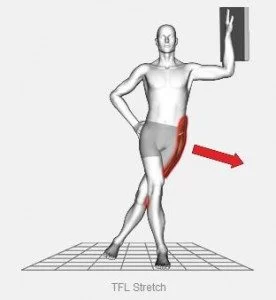
Tensor fascia latae stork standing stretch:
- The patient is in a standing position beside the wall & places the hand on the wall to support the body.
- Then Raise the leg which is closest to the wall & bends the knee joint & place it on the other leg’s right side above the knee joint to be in a stork standing position.
- Place the other hand tensor fascia latae muscle over the going to stretch.
- Then in the standing position on one leg, slowly bend them toward the wall.
- Keep the leg still & bend the torso.
- The patient feels the tension force over the tensor fascia latae muscle.
- Hold this position for 30 seconds.
- Repeat this stretching 3 times a day.
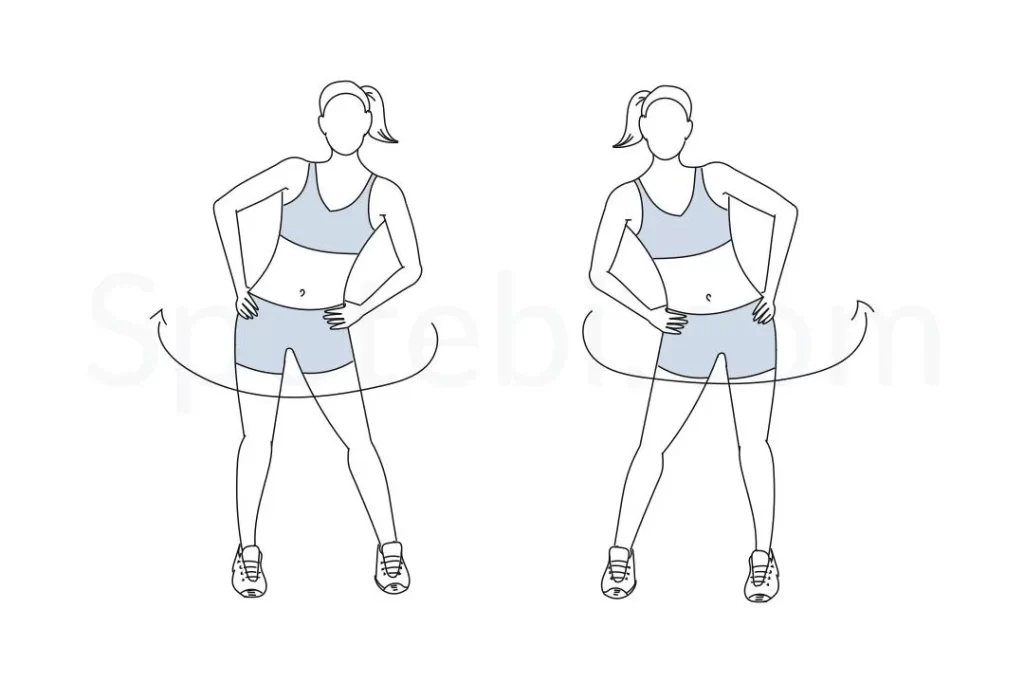
Hip circle stretch
- How to do stretch: Take a standing position with the feet around hip-width apart & your hands placed on the hips.
- Gently move the hips in a circular motion & make full circles.
- During this movement, you feel stretched into TFL.
- Repeat for 10 repetitions with 2 -3 sets then do other directions.
- Gradually increase the diameter of the circles.
Lying leg hanging stretcperform
- How to perform stretch: Take a side-lying position on one side on a bench or a bed, at the edge of this object.
- Put 1 hand under the head for support.
- Now lower down the upper leg at the edge of the bench/ bed.
- When they feel stretched into tensor fascia latae, hold it there for 30 to 60 seconds & do it 2- 3 times.
- Then do the other side.
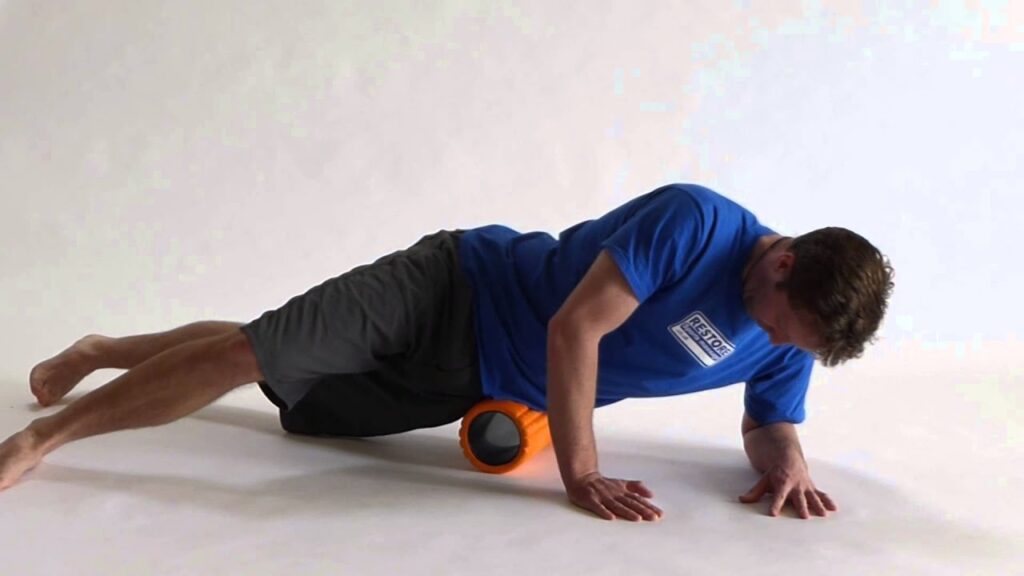
Foam roller to stretch:
- The patient is lying down on the foam roller on the right /left side in a way that the foam roller is placed on the upper lateral aspect of the thigh at the level of the side pocket one inch below the anterior iliac crest.
- Then place the opposite leg in front of the right leg.
- Support the body with the elbow on the floor. Then start to move slowly up & down on the foam roller from the anterior iliac crest level to 1/3 upper part of the thigh for 5 – 10 seconds.
- Hold this stretching position for 10 – 20 seconds.
Standing balance outer hip stretch
- Bring up the right leg & bend the knee, holding your ankle.
- You have to use your right hand for holding your ankle & your left hand to hold a static object for support.
- Slowly lean towards the right side to feel the stretch into the tensor fascia latae.
- Keep that position for 30 seconds & perform 2-3 times.
- Then do the other sides.
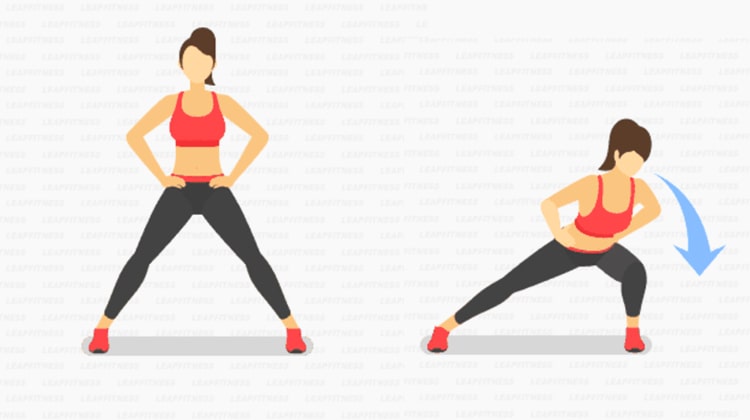
Standing leg cross abductor stretch
- How to do stretch: Stand tall with feet that might be hip-width apart.
- Take the left leg behind you crossing past the right foot.
- You can use the wall/another static object for support.
- Transfer the weight through the left leg that is crossed behind, and drive the hips forward.
- Keep the position for 30-60 seconds & do 2-3 times on each side.
- They do the sides by crossing the right leg in front of the left leg.
Leaning abductor stretch
- How to stretch: Take a standing position next to a wall with your feet might be closed together.
- Put the hand on the wall for extra support.
- Transfer the body weight towards your outer hip.
- Hold that pose for 30 to 60 seconds to feel a good stretch & perform it 2-3 times.
- Switch to the other side.
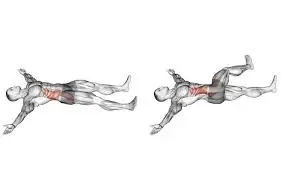
Iron cross stretch
- in a supine lying position your hands at your sides.
- Raise the right leg over placing the leg on the other side of the body.
- Try maintaining the pelvis forward & lower back on the floor.
- Hold it for 30-60 seconds & perform 2-3 repetitions on each side.
- Then do to the opposite side.
Static standing Tensor fascia latae stretch
- How to do stretch: Take a standing position in a staggered stance with your foot behind pointing outward & rotating the hip at 45 degrees angle.
- Contract the glutes transferring the body weight forward until you feel the stretch in TFL.
- push up across & back with the arm on the stretching side.
- keep that position for 30 seconds & do 2-3 sets.
- do to other sides.
Quadruped active Tensor fascia latae stretch
- How to stretch: Get down on the floor with hands placed under the shoulders & knees under your hips.
- Extend the right leg behind you by contracting the glutes.
- Now perform an external rotation of the hip pointing the toes at 45 degrees angle.
- keep neutral spine adducts your hip.
- Keep it for 30 seconds & 2-3 repetitions.
- do to another side.
Lunge Tensor fascia latae Stretch
- How to do stretch: Take a lunge position with the hands on the hip.
- Put one leg further by bending at the knee & the leg is straight backward.
- The straight leg might be your stretching leg.
- ensure to have both feet are in a line.
- keep the pelvis facing forwards at all times.
- Tilt the pelvis backward & move your hip forwards.
- Lunge forwards.
- go the hips out towards the side of the back leg.
- When you feel stretched, pause there for 30 seconds.
Kneeling Lunge
- How to perform stretch: Take a kneeling lunge position.
- Put a pillow underneath the knee.
- ensure to have both feet are in line with each other.
- keep the pelvis facing forwards during the stretch.
- Tilt the pelvis backward.
- Tuck the tailbone underneath you.
- Move the hips forwards.
- Push the hips out towards the same part of the back leg.
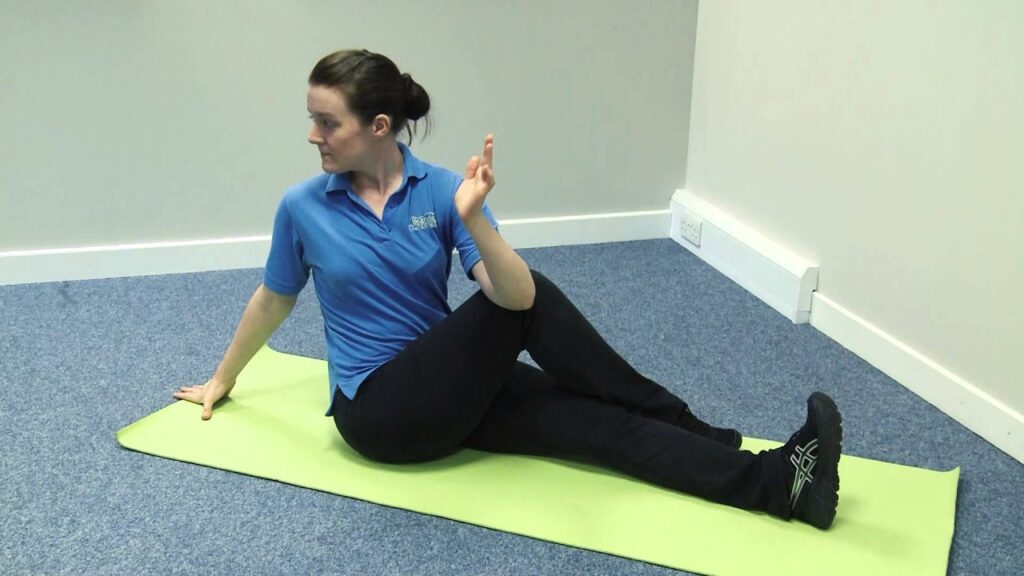
The Pretzel
- Take a supine position on the floor.
- slowly bend the knee.
- Move the knee towards the center.
- Put the other foot on the outside of your knee.
- Push the knee down towards the ground.
- push the tailbone underneath you & push the hips forwards.
- Keep these 30 seconds & repeat.
Side Lie Knee Bend
- How to do stretch: Take a side-lying position on 1 side.
- The hip on the upper part is stretching.
- Bend the knee backward.
- Hold onto the ankle & pull the foot towards the buttock.
- Try to take the leg back as much as possible without arching the lower back.
- Engage the buttocks & move your hips forwards.
- Let the knee drop toward the ground.
- When you feel stretched into tensor fascia latae, stop there & hold for 30 seconds.
What are the safety matters you might take care of?
There are some things you might require to take care of:
- Never think of stretching as a warm-up. You might hurt yourself if you try cold muscles. prior to stretching, warm up with light walking, biking, or jogging at low intensity for 5 -10 minutes. A much better idea is to stretch the muscles, after a workout when the tensor fascia latae muscles are warm.
- Do not bounce. do stretching in a smooth motion, without bounce. Bouncing during a stretch can injure the muscle & source muscle tightness.
- Hold the stretch. Breathe normally & hold every stretch for around 30 seconds; in problem parts, you need to hold for about 60 seconds.
- Do not aim for pain. Imagine feeling tension during the stretch, not pain.
- do stretching regularly, at least 2 -3 times a week.
- Do not skip stretching. because it will help to increase the range of motion. If you skip, it may decrease the movement.
Strengthening exercise of the tensor fascia latae

- Clamshell exercise with bands
- Sidesteps with bands
- Quadruped hip extension
- Quadruped hip extension with bent knee
- Single glute bridge
Clamshell exercise with bands:
- The patient is Lying down on the side with both legs together & knees bent at 45 degrees.
- Rest the head on the lower arm.
- Keeping the feet together, raise the upper leg as high as the patient can.
- Then the patient is Briefly paused at the top
- After that Slowly return to starting position
- Do the 3 sets per day & 10 reps on each side
Sidesteps with bands:

- The patient is Standing with the feet hip-width apart in an athletic stance with the knees slightly bent & leaning forward.
- Step to the side so that the feet are slightly wider than the shoulder width apart.
- Step the other foot towards the first foot.
- Repeat this exercise on the other side.
- Do the 3 sets per day & 10 reps on each side
Quadruped hip extension:
- The patient is Getting onto the floor with the hands stacked under the shoulders & knees under the hip joint.
- Keeping the back straight & engaged the core muscle.
- Press one leg up & back behind till the leg is fully extended
- Then Slowly return to starting position
- Repeat this exercise on the other side.
- Do the 3 sets per day & 10 reps on each side.
Quadruped hip extension with a bent knee:
- The patient is Getting onto the floor with the hands stacked under the shoulders & knees under the hip joint.
- Keeping the back straight & engaged the core muscle.
- Press one leg back behind keeping the knee joint bent at 90 degrees.
- Then slowly return to starting position.
- Repeat this exercise on the other side.
- Do the 3 sets per day & 10 reps on each side.

Single glute bridge:
- The patient is Lying down on the back with the knees bent & feet planted on the floor & arms on our sides for extra support.
- Then Lift one leg off the ground and extended it in front of the patient.
- Must be Keep the upper back on the floor & contract the glutes muscle.
- Push through the heel of the foot on the floor.
- Raising the hips off the ground till the knee, hips & shoulders are created in a straight line.
- Must be Keep the core muscle engaged the whole time pause briefly at the top for 1-2 seconds then return to starting position
- Repeat this exercise on the other side.
- Do the 3 sets per day & 10 reps on each side.
FAQ
The tensor fasciae latae works in synergy with the gluteus medius & gluteus minimus muscles to abduct & medially rotate the femur. The TFL is a hip abductor muscle.
Iliotibial Band Friction Syndrome/ IT Band Syndrome, is a common problem that can cause pain in the outside of the thigh or knee. This happens when the tensor fascia latae (TFL) muscle at the hip becomes overactive.
Stretching is ideal for pain relief; begin by placing your good hip in the opposing direction of the TFL to stretch. For successful results, the client might be laying the strain on a massage ball (or even a tennis ball), and moving the ball along the TFL until the strained part is evident.
Pain Patterns & Symptoms
Trigger points in the tensor fascia latae can cause pain on the outer/lateral side of the thigh, which is often described by patients as pain in the hip. The pain can also radiate to the lateral side of the knee.
Lie down on your back. Keep one leg straight and cross the opposite foot over that leg at the tibia level. Pull the straight leg gently with the foot toward the inside until you feel a stretch on the external portion of the straight leg. Hold the stretch for the recommended time.
Once you get to the root cause of the TFL overload and start turning on the right muscles, then the TFL can breathe again and the pain dissipates quickly. It will take 4-6 weeks to complete the 4 R’s so that the pain does not recur.
Activities that place excess strain on the TFL include climbing up or downhill without proper support, walking or running on sloped surfaces, excessive pronation, and sports like running or soccer that involve a lot of hip flexion and medial rotation.
Symptoms: Tensor fasciae latae pain presents as outer hip pain located at the TFL muscle belly. Pain when lying on the affected side, walking up and down stairs, running, walking, and hiking. Treatable non-surgically within weeks to months with complete recovery probable.
Self Treatment. The use of a spikey massage ball to target the TFL is a great way to self-manage tightness and give you some relief. You can perform this self-massage lying face down or standing if your muscle is too sensitive.
Role at the knee
Most of the comprehensive studies investigating the role of TFL in influencing knee movements and patella stability find it difficult to identify a direct role of TFL in knee function. It almost certainly does not contribute to knee extension, flexion, or rotation of Anatomy.
When gluteal muscles are weakened, the brain will often recruit TFL, sometimes in conjunction with piriformis. Over time, this can contribute to sciatic-like symptoms. Over time, this chronic shortening of the TFL can eventually pull on the IT band and result in ITB syndrome or knee pain.

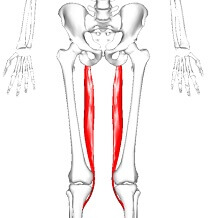
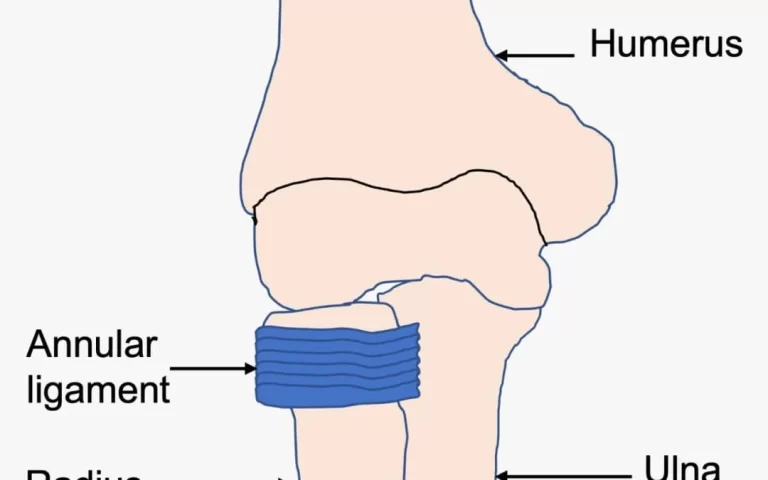
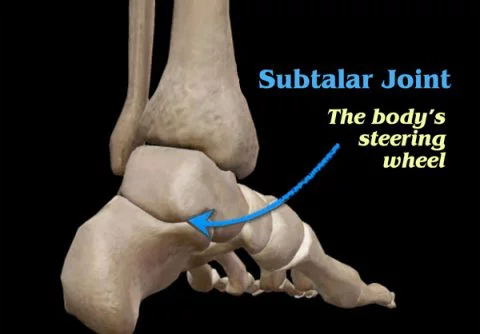
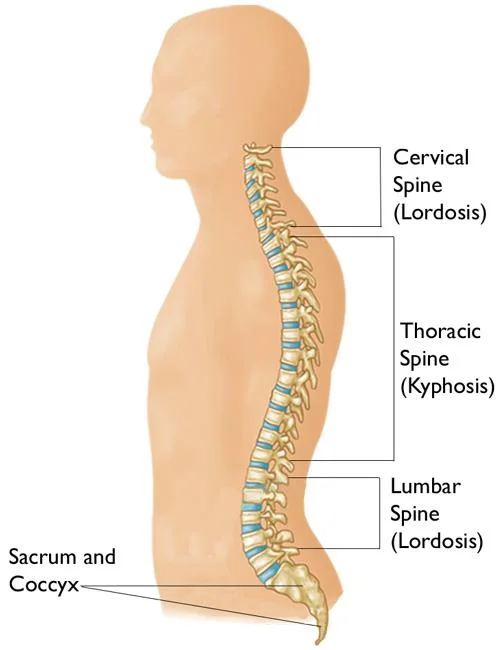
3 Comments